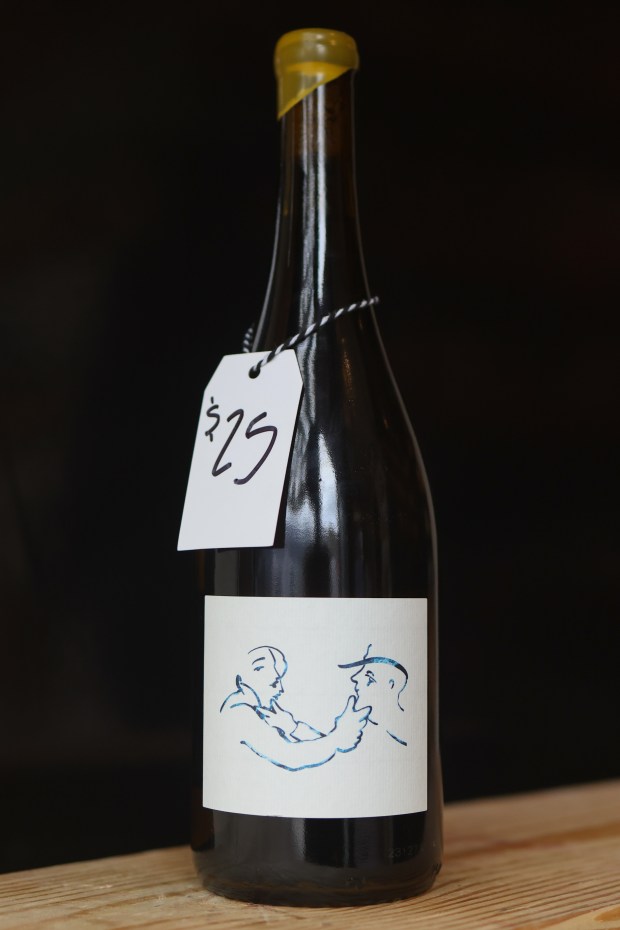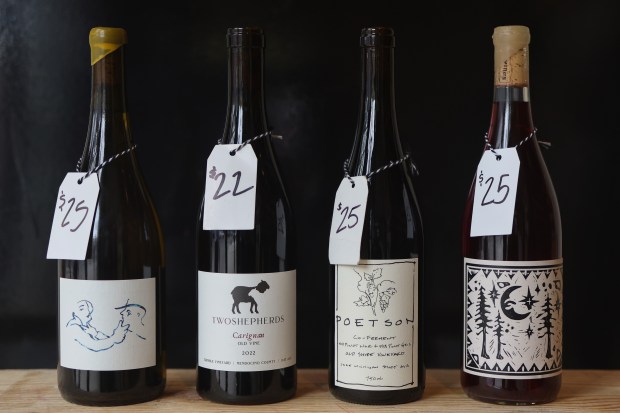Long before the rising cost of eggs and recession jitters invaded our daily conversations, cost was already the dominant factor steering America’s wine choices. Now, as tariffs threaten to send import prices soaring, domestic wines might be poised to be a value alternative for many American consumers.
But navigating the landscape of value in American wines is complex, explains Zack Eastman, co-owner of Easy Does It, the wine bar and bottle shop in the Logan Square neighborhood.
Indeed, there’s no shortage of cheap American-made wine. Grocery stores and big-box retailers are overstocked with mass-produced wine brands engineered for the kind of easy drinking consistency consumers enjoy from soda or energy drinks.
Yet value in wine implies so much more than just cost, says Eastman. As an agricultural product, value represents a balance of cost against a range of other factors like quality, sustainability, ethics and farming practices, he suggests.
At the opposite end of the price spectrum, America’s most iconic wines — Napa cabernets and Sonoma chardonnays, for example — known for craftsmanship and distinctiveness, can be prohibitively expensive, especially compared with imported wines. After all, in the pre-tariff era, American consumers have enjoyed unfettered access to a smorgasbord of fine value wines. Almost any wine shop in America is stocked with solid Côtes-du-Rhône reds, Argentine malbecs or New Zealand sauvignon blancs at under $15. Yet even the most mediocre Napa cab is a challenge to find under $25.
Generally, high-quality American wines from independent producers simply cost more to make than imported wines of similar quality.
“It’s incredibly difficult for small American producers to compete in that under-$15 range,” says California winemaker Joey Tensley. “In Italy, a family making pinot grigio likely inherited their winery over generations.”
Here, independent producers face massive upfront investments. They’re buying their own land, equipment and production facilities, even before tackling labor, farming and distribution expenses.
“Even at $19.99 a bottle, the margins are so thin, producers might only be making a couple dollars per bottle,” says Tensley.
His company, Tensley Wines, is best known for small production, premium Syrah grown on his own estate in the Santa Barbara American Viticultural Area, or AVA. Tensley’s flagship wines retail for over $115. But by purchasing grapes from a handful of larger growers across the broader Central Coast AVA, Tensley was able to launch Fundamental, a second, more accessibly priced label, which retails for under $25.
Tensley’s business model sheds light on where consumers will find the best values in quality American winemaking today. Like many independent producers, he focuses on lesser-known appellations outside the spotlight (and price tags) of places like Napa or Sonoma. By sourcing grapes from trusted growers rather than relying entirely on estate-grown grapes, Tensley can deliver affordable wines without buying more land or expanding his own farming operations. And with an annual production of about 27,000 cases, his operation has remained small enough to ensure that his wines retain his distinct signature.
At The Oakville Grill & Cellar in Fulton Market, wine director Grant Barnow showcases plenty of marquee bottles from Napa and Sonoma. But some of the most compelling values, he suggests, “come from names and regions off the beaten path, many that might sit outside your comfort zone.”
Like Tensley, Barnow points to the Central Coast, the catch-all AVA that stretches from the San Francisco Bay down to Santa Barbara County, as a hot spot for wines of both value and distinction. But he also finds standout bottles in smaller, lesser-known subregions of the Central Coast like San Benito County, as well as further north in Mendocino County. Inland, he looks to areas like Lodi and Clements Hills in the Central Valley, or the Sierra Foothills and Amador County near the Nevada border.
These under-the-radar corners of California feature prominently at Easy Does It too, but Eastman is quick to point to other underappreciated American wine regions like the Finger Lakes in New York, Michigan and the Columbia Valley in Eastern Washington and Oregon too.
Even for seasoned professionals, navigating these lesser-known American wines means sorting through a flood of unfamiliar names and wine styles — something that requires legwork, admits Vernon Jackson, a wine consultant and sommelier at Tre Dita in Chicago’s Lakeshore East neighborhood. After all, the landscape of American wine is so wonderfully vast and varied, it defies simplification into a quick and dirty cheat sheet of regions or producers
His advice? “Find a local, independent wine shop you like.” Be upfront about your budget, ask plenty of questions and take time to build a relationship, he says. And most importantly, “be fearless” in exploring unfamiliar grape varieties, regions or producers you might not know yet.
After all, so much of wine’s value lies in the discovery, Jackson explains. “Wine is something that transports you — to another place, another moment in time.” By reclaiming it as an agricultural product rather than a branded commodity, he argues, “it becomes the story of the individual families, the people who grow grapes and make wine by hand. All of that is what gives wine so much value.”
10 American wines at $25 and under that punch well above their price point
Floréz 2023 Poilu’s Pinard Cienega Valley Red Blend, $25 at Easy Does It
Sourced from the Cienega Valley in the Central Coast, this is an unusual co-ferment of organically grown red and white grapes like zinfandel, mourvèdre, muscat, grenache and cabernet pfeffer. Winemaker James Jelks’ wines are “a great example of how great natural wines can be,” says Eastman. They’re very clean and well-made but “super fresh, crunchy and really easy to drink,” he says.
Two Shepherds 2022 Old Vine Mendocino County Carignan, $22 at Easy Does It
“These wines are so good,” says Eastman, and the couple who make them, William Allen and Karen Daenen, “work so hard” making small-batch wines from 80-year-old vines. “I almost feel bad pricing these wines as low as we do,” he says. The carignan, a red grape more commonly found in Spain and southern France, is farmed organically in Mendocino, just north of Sonoma County.
Barbichette 2023 Le Blanc Seneca Lake Riesling, $25 at Easy Does It
“There’s so much great wine coming from New York,” says Eastman, with many that overdeliver for their price. “This is an atypical riesling that reminds me more of places like the Jura in France than Germany,” he says. “It’s fully dry and high in acid but also very light in alcohol with a really cool, salty minerality.”

Poetson 2023 Old Shore Vineyard Co-Ferment Lake Michigan Shore Pinot Noir and Pinot Gris, $25 at Easy Does It
“In Chicago, we’re such big supporters of local products, I’ve never had trouble selling Michigan wine,” says Eastman. “We’re just starting to see how much potential there is there.” This co-ferment of red pinot noir and white pinot gris is from winemaker Alex McNeely’s first commercial vintage. “It’s so fresh and crunchy,” Eastman says, “it drinks more like a light red wine with these floral and citrus tones you might not usually get in a red.”
Joey Tensley 2019 Fundamental Central Coast Cabernet Sauvignon, $25 at Total Wines
Finding a California cabernet that preserves the variety’s classic tension, perfume and peppery freshness at an accessible price is rare. While Tensley is best known for Rhône varieties like syrah and grenache, his entry-level cab delivers impressive value, offering glimpses of the purity of fruit and intensity that define his more powerful flagship bottlings.
Bedrock Wine Co. 2024 Ode to Lulu California Rosé, $24 at Brix26.com
This grenache-based rosé is Bedrock’s homage to French winemaker Lulu Peyraud of Domaine Tempier in Bandol “who makes one of the greatest rosés in the world,” says Barnow. “It feels like southern Provence,” but with a twist of California sunshine, he says. “A phenomenal rosé that’s the perfect summertime glass with a bit more complexity to it.
Monte Rio Cellars 2024 The Bench Clement Hills Lodi Vermentino, $25 at Monte Rio Cellars
Vermentino, a white wine typically found in Italy or France, is a rarity in America, but wines made from lesser-known grapes can also offer substantial value, compared with more commonly marketable varieties, says Barnow. Sourced from a grape grower in Lodi in California’s Central Valley, it’s an orange-style wine made by the former New York City sommelier Patrick Cappiello. “Its delicate herbal tone and touch of tangerine skin make it such a pretty wine,” says Barnow.
Tatomer 2024 Steinhügel Santa Lucia Highlands Riesling, $22 at Tatomer Wines
Despite an exceptionally small production, Graham Tatomer has an outsized reputation for making incredible riesling at consistently low prices, says Barnow. The Santa Lucia Highlands in California’s Monterey County “is another lesser-known region, but this bottling hits all the bright, beautifully concentrated notes of riesling in a very dry, Austrian style,” Barnow says.
Maison Noir Wines 2023 O.P.P. Willamette Valley Pinot Noir, $23 at Binny’s
Maison Noir is the long-running micro-négociant project of André Hueston Mack, a former sommelier, who sources fruit from select vineyards across the Willamette Valley — hence the nickname the “Other People’s Pinot.” The result is an accessible Oregon pinot with “tart red fruit acidity” that makes it “so great to crush,” says Jackson. “It goes so well with so many foods.”
Day Wines 2023 Vin de Days Willamette Valley Blanc Natural, $21 at Binny’s
Winemaker Brianne Day blends organically grown pinot gris, riesling, pinot blanc, müller-thurgau and muscat grapes sourced from a select group of growers in Oregon’s Willamette Valley to make this perfumed Alsatian-style white. It’s a rare blend here in the United States, perfect for consumers curious about natural and organic wines, says Jackson. “It’s a crushable white wine, especially with some chill on it,” he says.
Anna Lee Iijima is a freelance writer.





